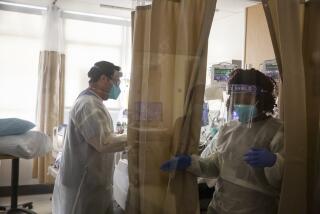Medical Group Issues Resident Work Limits
- Share via
CHICAGO — Doctors-in-training in the United States -- many of whom work marathon shifts that critics say lead to medical mistakes -- cannot work more than an average of 80 hours a week, a body that accredits medical residents said Tuesday.
Under new rules approved by the nonprofit Accreditation Council for Graduate Medical Education, medical residents must also get one day off out of seven.
The regulations also require a 10-hour rest between being on-call and working a shift.
The rules, which schools must follow to be certified, take effect July 1.
The vote by the council’s board of directors means that the standards “go from being a should, to a must” in order to pass muster with the accrediting body, said Julie Jacob, a spokeswoman for the group.
Medical residents and the consumer group Public Citizen prefer federal standards, saying a private group lacks teeth to enforce the rules. But the government rejected a petition to a federal agency on that front last year.
The Committee on Interns and Residents, a union that represents 12,000 residents in the United States, said the move “is going in the right direction, but the weakness is enforceability,” according to executive director Mark Levy.
Another flaw involves loopholes that allow residents to extend, for example, the 24-hour shift limit by six additional hours, Levy said.
The union is working to enact tougher laws on the state level, using a New York law as a model.
Critics say residents are overworked, clocking an average 120 hours per week, a situation they say leads to medical errors and deaths.
By making the standards mandatory, the accrediting group and the American Medical Assn. hope to head off federal legislation on residents’ hours.
Certification with the council is voluntary, but many medical colleges seek it for recognition, state board certification and to qualify for federal Medicare funding.
The group accredits about 7,800 residency programs involving 100,000 trainees.
More to Read
Sign up for Essential California
The most important California stories and recommendations in your inbox every morning.
You may occasionally receive promotional content from the Los Angeles Times.













